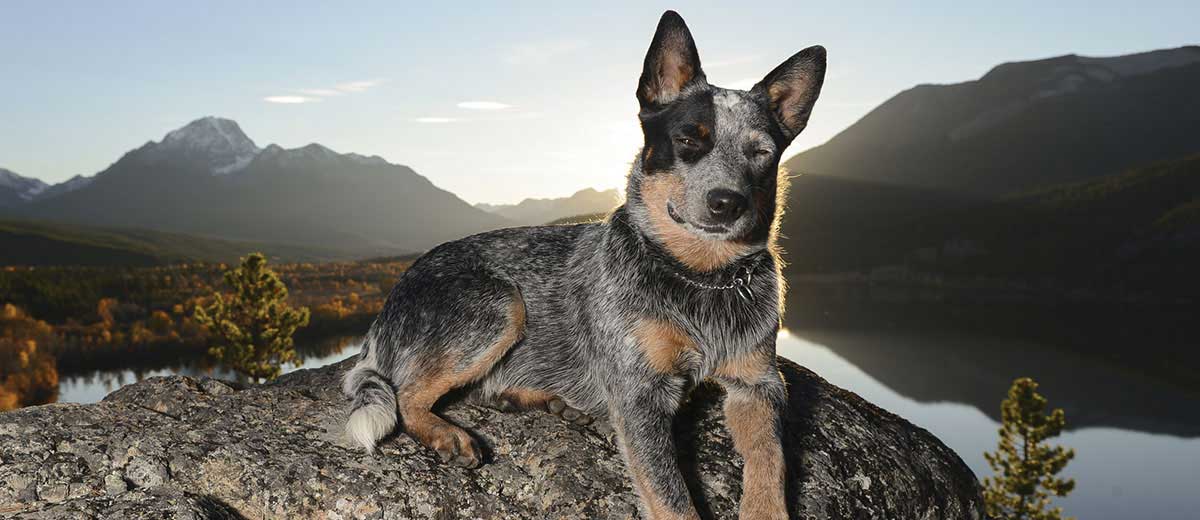Australian Cattle Dog
Parents of small children will immediately recognize the Australian Cattle Dog as the basis for the popular Australian television show, “Bluey.” (Bluey’s last name on the show is Heeler, nodding to the dog’s other name, the Australian Blue Heeler.) These dogs have a moderate build that gives them endurance, speed, and extreme agility, all nodding to their history as cattle herding dogs.
Their gait is tireless and they are capable of quick and sudden movements. A water-resistant coat has developed over time to help them work, no matter the weather. Even as family pets, Australian Cattle Dogs require an intense amount of physical and mental stimulation.
Breed characteristics carousel
Learn More
Need to Know
- Dogs suitable for experienced owners
- Extra training required
- Generally healthy breed
- Enjoys active daily walks
- Medium dog
- Minimal drool
- Requires frequent grooming
- Chatty and vocal dog
- Barks, alerts, and may be physically protective/suspicious of visitors
- Could have issues with unknown dogs but gets along with known dogs
- May need additional training to live with other pets
- May need additional supervision to live with children
- Needs a small yard, but prefers rural areas
- Can be left alone with training
- AKC Registered Breed

Personality
Often cited as headstrong, stubborn, energetic, and hardworking, Australian Cattle Dogs love a challenge, whether physical or mental. Natural Energizer Bunnies, these dogs love to silently herd and learn new things. Given their instincts, they tend to nip at heels, especially when small children are running but do well with older children.
The cattle raised on Australian land in the 1800s were wild and untamed, and the traditional European herding dogs brought over weren’t really up for the job. There was a need for a dog that could travel long distances over the rough terrain of Australia in punishing temperatures—and one that could do so without barking at the cattle and startling them.
Blue merle Highland Collies were bred with wild Dingos in 1840, producing Hal’s Heelers. Other breeds were crossed including the Bull Terrier, Dalmatian, and Black and Tan Kelpie. The resulting dogs had all the endurance, ruggedness, instincts, and protectiveness needed to pull off the job.
As the dogs became increasingly vital to the cattle industry of Queensland, they gained the name Queensland Blue Heeler. They later became known as Australian Heeler, and then Australian Cattle Dog. They debuted in the United States in the 80s.
If you enjoy the outdoors and live on a lot of land, you will set the Australian Cattle Dog up for success. They love rural life, especially if they can be put to work herding cattle. If you can’t provide cattle, then long walks and time spent herding giant exercise balls or taking part in competitive dog sports will suffice for this tough, workaholic dog.
The Australian Cattle dog needs exercise every day, including mental stimulation and training. They have great stamina and endurance and will happily accept much more exercise time. This is a very agile dog and an independent thinker, so it is better not to leave them unsupervised or bored for long as they might become noisy and destructive.
So long as you have access to lots of land for playing and exploring, the Australian Cattle Dog is happy. They have been bred to work out how to get around obstacles in the course of their work, making them excellent little Houdinis. Given their natural desire to react to movement and control moving objects, this is a breed better kept away from busy roads and bustling pavements. Quiet rural or farm homes will suit this breed much better than town or city.
The Australian Cattle Dog needs to bring out dead hair, making them relatively low maintenance. If wet and muddy, allow them to dry and watch the dirt easily brush off. Paws and ears should be checked daily for things like thorns.
Agile and ready to show it off, the Australian Cattle Dog enjoys sports and activities that cater to this eagerness and enthusiasm. They love training and learning, and it won’t be hard to find an activity that your Aussie Cattle Dog will excel at. Teaching them to relax, however, might be harder.
A wrangler at heart, they prefer that groups stay together and move along at a pace they dictate, including their own families. Families with small children might find this burdensome. Australian Cattle Dogs require a lot of time to exercise and train which may conflict with family time commitments.
The cost of an Australian Cattle Dog from a breeder is significantly more than the cost of adopting one from a local shelter or rescue. The adoption fee usually covers additional items such as spaying or neutering, vaccines, and microchipping.

Learn more about feeding and caring for your Australian Cattle Dog on Purina.
Did You Know?
- The Australian Cattle dog was intentionally bred with the Australian Wild Dingo. Their ties to the Dingo mean that they have impressive stamina and many owners report that they have seemingly endless energy.
- One of the oldest dogs in the world was an Australian Cattle Dog called Bluey. He lived to be 29 years old.
- The popular television show “Bluey” features a family of Australian Cattle Dogs.


